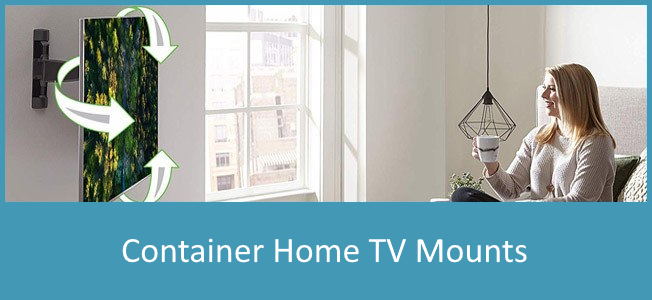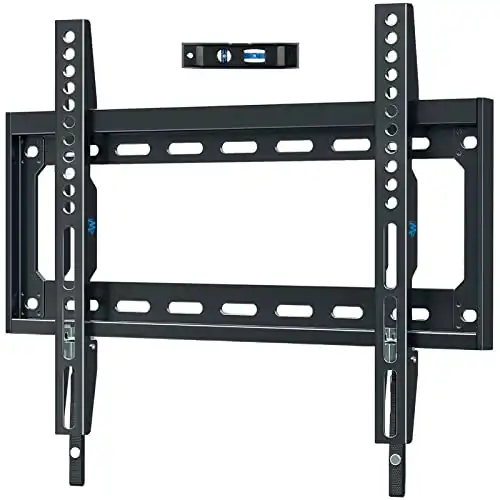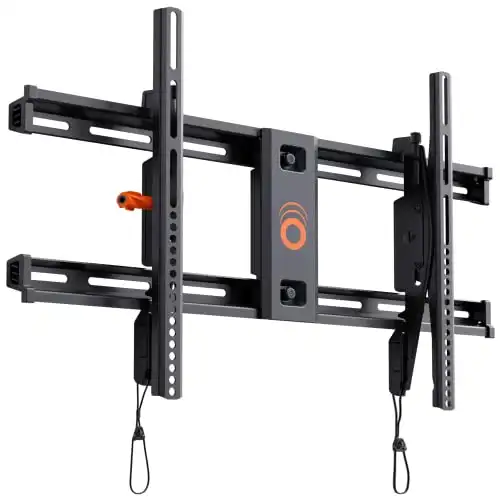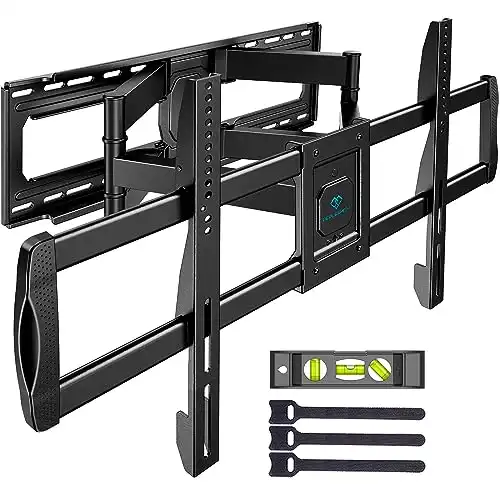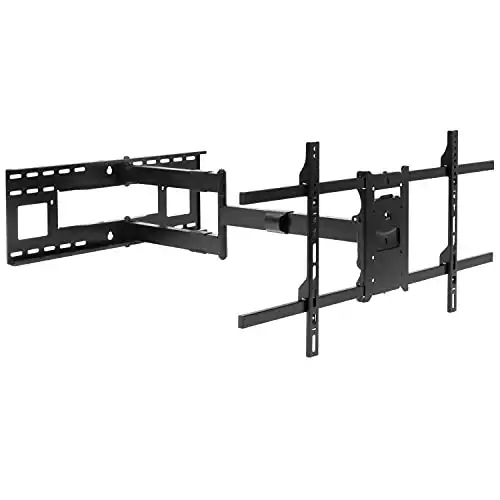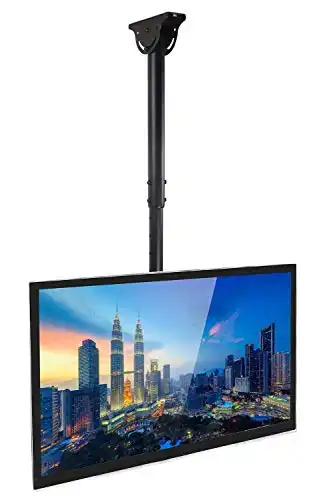In many cases, a container home is synonymous with tiny house living. It’s about reducing clutter, reducing household expenses, and maximizing life enjoyment.
People who have chosen this lifestyle or who are thinking about it understand how precious every inch of available space is. A tiny living area or bedroom can easily feel cramped if you don’t use a TV wall mount to get it off the floor and out of the way.
TVs are large, require space from seating, and are generally an interior design challenge for smaller spaces. And since over 90% of households have TVs in most western countries, we’re dedicating an article specifically to the best ways to incorporate them into your home.
Disclosure: This post contains affiliate links, meaning that we may receive a small commission (at no additional cost to you) on any purchases you make after clicking on these links. Click here for more information
TV Placement
Managing a small living space means that many of your items need to perform double duty. Small sectional couches may become a guest bed. Ottomans have bulk storage underneath. And walls and cabinets are used to their maximum potential.
This space management applies to your TV set as well. You won’t have any extra floor or counter space so a great option for a TV is to mount it on the wall. Wall mounting your TV also provides the added benefit of reducing the chances of injury or equipment damage if small children are around.
Before you’re ready to purchase a mount, you have a few decisions to make.
Which rooms need access to a TV?
The most common location for a TV is the living or family area. But you may also want one for the bedroom, dining area, or even outdoor spaces.
How many TVs will you have in your home?
If you gave two or more answers to the question above, you now have to consider if you’ll have multiple TVs. Note that these two questions are actually mutually exclusive.
TVs can be shared between rooms by moving and rotating. For example, you can use a partial wall to segment a sleeping area from the living space, and with a rotating allow a TV to be viewed from both sides of the wall. Or you could use an articulating mount to angle a TV towards you depending on which room you’re currently in.
How will you be positioned when you watch TV?
For a given TV serving a given room, it’s important to understand the position of viewers related to the TV. Although newer TVs have wider viewing angles than those of the past, your TV will look best when it’s viewed straight-on at eye level regardless of the display type.
Knowing that, thing through your physical positioning in the room where you’ll be watching a TV. Will you be sitting, standing, or laying down? What is the height of the furniture you’ll be using (For instance, an elevated bed really changes your viewing angle!)
Your horizontal positioning is just as important as the vertical. If you’re at the right eye height but off to the side, you’ll still be off-axis and have a less than optimal viewing experience.
Keep in mind that even if you have a TV mount that allows you to angle the TV toward you, you may still have to adjust your body in relation to the furniture in order to look at the TV. This may not seem like such a problem, but after an hour or more it can introduce some bodily strain.
Have you ever arrived later to a movie theater and had to sit far to one side? If so, and you developed a sore neck at the end of the movie, you know this feeling all too well.
None of what we’re describing is the end of the world of course, but if you have a chance to design your home in a better way, why not take it? You deserve to be settled in and comfortable whether you’re watching the news or having a movie night.
The benefit of mounting a TV in a container home, or at least one that is tiny, is that your home design is usually less restrictive and more open. There are typically few interior walls and everything is multi-functional. This open concept means you have a lot of options for placing viewers and the TV itself.
How will you position and install the TV in the room?
The placement of the TV is the close cousin of the positioning of viewers. And there are several items to consider for optimal placement.
When positioning the TV using a wall mount, you need to consider what will be behind the wall. Things like electrical wires and plumbing lines can potentially be in the way of your mounting system. And you’ll obviously need a strong wall to mount to, which optimally includes strong studs or other structural members that can support the weight of the TV and mount.
Another factor is lighting. This includes not only electric lights but natural lighting as well from windows and doors. There is nothing more frustrating than trying to watch something that is obstructed by glare. So be conscious of all sources of light and consider adjusting their position (or that of the TV) to ensure a clear view.
If you want a professional-looking TV mount, you’ll want to make sure you have a power outlet positioned close to the mount in a way that doesn’t interfere with it. This will prevent having the dreaded power cord draping beneath the TV, which is unsightly and potentially dangerous.
Finally, we strongly recommend that you have another person to help you when you install the mount. They can help hold larger TV’s that are heavy and unwieldy, plus check for positioning and level while you temporarily hold the mount in place.
Features That Distinguish Wall Mounts
Not all mounts are created equally, even those of the same general size and configuration. Just like any other product, some mounts are strong, durable, and have a high-quality finish. Others cut corners and may not necessarily perform as well or last as long. Here are a few things to look for:
- Movement Limits: Two similar-looking tiltable mounts may have varying levels of possible tilt. Depending on your room design and TV placement, just a few degrees can make a big difference.
- Size and Weight Capacity: All mounts should list the weights of the TVs it is compatible with, along with the size. Both measures are important. The weight capacity ensures the mount can support the TV without bending or breaking. And the size capacity ensures a larger TV won’t hit its edges before the movement limits are reached.
- VESA Compatibility: The VESA industry group controls how a mount physically attaches to the TV. If you look on the back of your TV, you’ll see a partner of threaded holes in a square or rectangular shape. Since there are a few different types of VESA mounting systems, you’ll need to ensure that the configuration of the holes on the back of your TV is compatible with the mount you select.
- Post-Install Leveling: Better mounts have the capability to make small adjustments for final leveling in case you don’t get the mounting holes perfecting positioned.
- Durable Construction: A more premium mount is going to include parts that won’t bend (even the non-structural ones), paint that won’t chip, etc. Some mounts are approved by the Underwriters Laboratory (UL), which you’ve probably seen on many other household products. This certification ensures the mount has been tested to exceed it’s listed weight rating and gives you additional peace of mind. This can be especially important if you may get a larger TV in the future, plan to add a soundbar under the TV, etc.
Choosing the Best Type of TV Mounts for your Container Home
We previously discussed several factors that influence good mounts from bad ones. Now to highlight some of our favorites, we’ll segment mounts by both their range of motion and their anchoring point.
Fixed Wall Mount
A fixed mount is the cheapest, simplest option. It gets your TV mounted onto the wall but offers no viewing angle adjustment whatsoever, so positioning it correctly is important.
Depending on your perspective, one main aspect of a fixed mount can be a pro or a con. Thanks to their simple construction, fixed mounts often offer the most flush mount, meaning closest to the wall. This can make the mount look more modern and professional, with less chance of seeing the birds nest of wires behind the TV.
The downside of this is if you anticipate having to plug and unplug wires from your TV often, especially if the connections are on the back. In many cases, plugging in a wire can involve temporarily taking the TV off the wall just to reach the plug. But for most people, this isn’t something you’ll be doing frequently.
The mount above from Mounting Dream handles TVs from 26 inches to 55 inches, weighing up to 100 pounds. It works with both 12 inch and 16 inch stud spacing and VESA mounts up to 400mm x 400mm. When mounted, your TV will only be 1.1 inches from the wall.
Tiltable Wall Mount
With a tilting TV mount, you pay just a little bit more than a fixed mount to get some up and down tilting adjustment. This tilt enables you to compensate for daytime glare a bit, or a standing versus sitting position. However, you cannot adjust these mounts to swivel or tilt side to side.
Many tilting TV mounts use small knobs or screws to secure the TV in its tilted position. Because of how close the TV is to the wall, it’s often hard to access the adjustment. If you think you’ll need to adjust your tv up and down frequently, ensure your mount allows you to get to the adjustment controls easily.
This ECHOGEAR mount offers 10 degrees of up and down tilt in exchange for having the TV 2.3 inches from the wall. It handles rectangular and square VESA configurations up to 600 mm x 400 mm and TVs up to 82″. If you get your mounting holes drilled a bit off, don’t worry because this mount provides 5 degrees of leveling adjustment.
Full-Motion (Articulating) Wall Mount
Full motion mounts are the most expensive but most capable type of mounts. The offer adjustments for swivel, tilt, and movement off of the wall. And because the TV is held further out from the wall, the tilt limits are often larger than with a simpler tilting mount.
One added benefit of a full-motion mount is that you can pull the TV out and position it perfectly for optimal viewing no matter how you’re relaxing, then push it back flush with the wall when not in use. The adjustability also means you’ll always be one step ahead of any glare that tries to ruin your viewing experience. However, because of the mechanism that enables the adjustment, full-motion mounts will cause the TV to stick out further than other mounts, even in the fully retracted position.
With the PERLESMITH mount above, you get a lot of features for a reasonable price. Capacity for TVs from 50 inches to 90 inches and up to 165 pounds. Tilt limits are 5 degrees down and 15 degrees up, swivel limits are 60 degrees in either direction, and there is even 3 degrees of leveling adjustment. It handles square and rectangular VESA mounting systems up to 800 mm x 400 mm, holds then TV at 3.07 inches from the while extending out to 23.62 inches.
The Mount-It! mount above is a substantial jump in cost from the PERLESMITH mount, but it provides a feature that many container homeowners will love: long arms. It costs more because of the larger forces the longer arms have to be built to support but it allows you many more configuration options.
This mount can extend the TV out up to 40 inches, and more importantly, offers up to 180 degrees of swivel along with 10 degrees up and 5 degrees down tilt adjustment. It also has 5 degrees of leveling adjustment. It handles VESA systems up to 800 mm by 400 mm and TVs from 42 inches to 80 inches weighing up to 110 pounds.
In case you’re not getting a feel for what this mount can do, we’ll spell it out. With this mount, you could pull your TV out off the wall and swivel it 90 degrees to either side so the TV is perpendicular to the wall. You could then swivel it 180 degrees so it is facing the other direction, still perpendicular to the wall. In this way, one TV could be adjusted for viewing in two adjacent spaces. Pretty neat!
Ceiling Mount
Given the comparatively low ceiling heights in containers, a ceiling mount is a less common option. But ceiling mounts can be useful if your container home design includes a bridging element or similar feature that provides a high ceiling. Most ceiling mounts offer swivel, tilt, and height adjustments. They also typically have a rotating base that allows you to mount on a sloped ceiling.
This ceiling mount, again from Mount-It!, is a leading option for these types of mounting systems. It handles TVs from 32 inches to 70 inches weighing up to 110 pounds with VESA patterns up to 600 mm by 400 mm. It adjusts in height from 22 inches to 36 inches and can tilt down up to 25 degrees.
Final Thoughts
Living small means being creative about ways to keep your tiny space neat and uncluttered. For those of us who enjoy winding down by watching TV or catching a Netflix movie at the end of a hard week, having the TV in a good spot is important. Purchasing a compact TV mount not only lets you watch TV comfortably but also allows you to maintain more free space in your container home.

